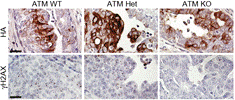Veterinary and Biomedical Sciences, Department of
Document Type
Article
Date of this Version
10-26-2004
Citation
Proceedings of the National Academy of Sciences (October 26, 2004) 101(43): 15,434-15,439.
Abstract
SJL mice are highly susceptible to experimental autoimmune encephalomyelitis (EAE) induced with myelin proteolipid protein (PLP) peptide 139–151, whereas H-2 congenic B10.S mice are resistant. Immunodominance and susceptibility to EAE are associated with a high precursor frequency of PLP 139–151-specific T cells in the naive repertoire of SJL mice. To understand the mechanism of EAE resistance in B10.S mice, we determined the precursor frequency of PLP 139–151-reactive T cells in both strains by using IAs/PLP 139–151 tetramers. SJL and B10.S mice had similar frequencies of tetramer-reactive T cells in the naive peripheral repertoire. However, in SJL mice, the majority of PLP 139–151 tetramer-positive cells were in the CD4+ CD25+ population, whereas there were more tetramer-positive cells in the CD4+ CD25+ population of B10.S mice. Depletion of CD4+ CD25+ cells in vivo facilitated the expansion of PLP 139–151-reactive cells with production of T helper 1 cytokines in EAE-resistant B10.S mice. Furthermore, anti- CD25 Ab treatment before immunization resulted in EAE induction in these otherwise resistant mice. These data indicate an important role for autoantigen-specific CD4+ CD25+ cells in genetic resistance to autoimmunity.
Included in
Biological Phenomena, Cell Phenomena, and Immunity Commons, Immune System Diseases Commons, Medical Biochemistry Commons, Medical Microbiology Commons, Medical Neurobiology Commons



Comments
Copyright 2004, PNAS. Used by permission. Edited by James P. Allison.